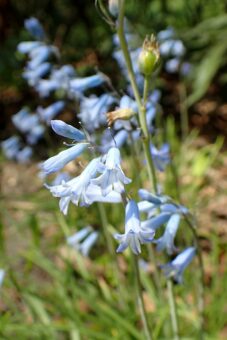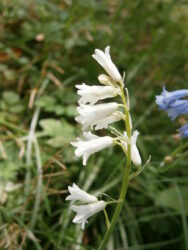In this article, we will discuss how to grow the not often seen but still colourful bulb of Brimeura in containers. Brimeura is a bulb-forming perennial plant that belongs to the Asparagacaea (the Asparagus) family, where 3 species are known to exist. The Dutch hyacinths you will find everywhere but not the Spanish ones. It can be said to be the showier than the Dutch Hyacinth and flowers later.

Brimeura is generally found growing in South-East Europe and on certain islands in the West Mediterranean. It is believed it gets its name after the 17th century Netherland botanist Marie de Brimeu. The leaves are narrow green and nothing special but in late spring to early June, tall upright spikes with 10 to 15 delicate bluebell-like flowers appear. The flowers are normally blue but they can be white.
Find out how to grow this hardy bulb in containers in this article.
GROWING BRIMEURA IN CONTAINERS
You can either grow it from bulbs or from seed, where the former is easier if you can find the bulb.
GROWING FROM SEED
In March, fill a seed tray with a sandy seed compost made by mixing 80% by volume seed sowing compost with 20% by volume of fine sand. On top of this, sprinkle the seeds thinly and just cover them with a fine layer of sieved compost. Place it in a cool room and after one to two months, the seeds should emerge. Allow them to grow on and when large enough to handle, prick them out and transplant them into 7.5cm pots full of multipurpose compost. Allow them to grow on in a cold frame outside and after a year in late spring, you can then plant them outside.
Bulbs and home-reared plants can be planted by using moderate size containers with plenty of drainage holes in them. To this container add a 1cm layer of gravel and on top of this add multipurpose compost to within 5cm of the rim.
You can plant bulbs 10cm apart and 10cm deep in autumn, whilst plants can be planted by digging rootballs that are slightly bigger than the root ball it came in the original container. Drop the plant in so that the top of the root ball is at the same level as the top surface of the compost. Backfill with the growing media so that no gaps remain, using more compost if necessary. Firm the plant in and water well.
CARE INSTRUCTIONS
You can place the container in full sun or partial shade. You will need to water when 5cm below the top surface of the compost feels dry to the touch, especially important when you are going through a period of drought.

In every spring, you will need to fertilize with a handful of slow-release fertilizer to give a boost through the growing season. You can mulch with compost in autumn to protect the bulbs. When the leaves have completely dried out and died, you will need to remove them.
Every 3 years or so, the plant will become overcrowded and will need to be divided, where each division will have one or two growing points. This is best done in summer whilst still in leaf.
PESTS AND DISEASES
The good news is that the plant is relatively pests and diseases free, where often no harm will come to the flowers or the leaves.
VARIETIES TO GROW
The only species you are likely to find is Brimeura amethystina which produces 1cm long tubular blooms in May or June. There is a dark blue variety and a white variety ‘Alba’. This is showier and more vigorous than the blue ones.
CONCLUSIONS
In this article, we have discussed how to grow the great alternative to Dutch Hyacinth in the container garden-Brimeura, the Spanish Hyacinth. They look not only attractive but make a great alternative to the often seen bluebells and hyacinths in the garden. Easy to grow, easy to look after, pests and diseases-free and easily propagated. A bulb for spring.
If you have any questions or comments that you wish to make on growing Brimeura in containers. Please do so in the comment box below.
Happy Brimeura growing.
